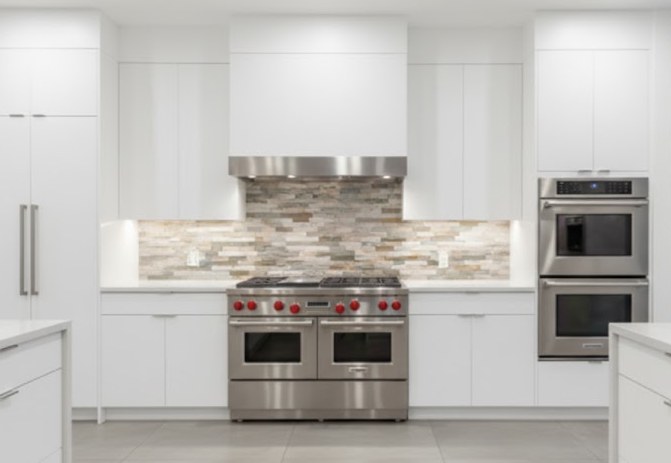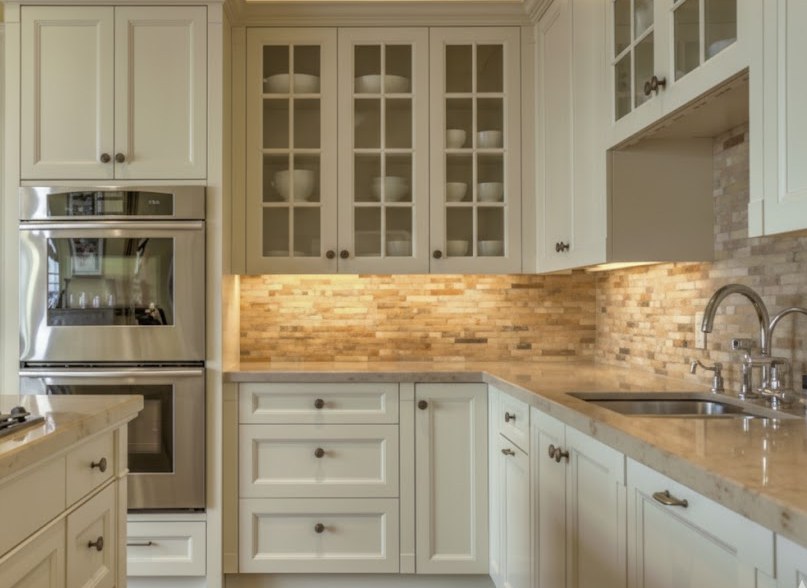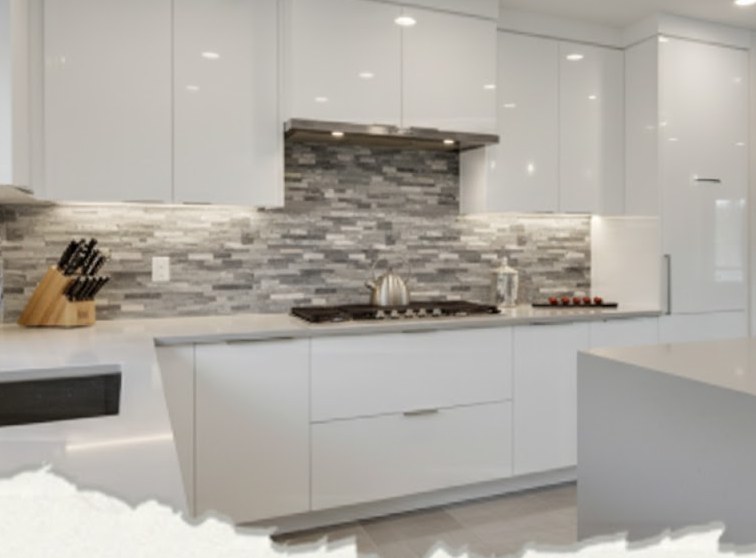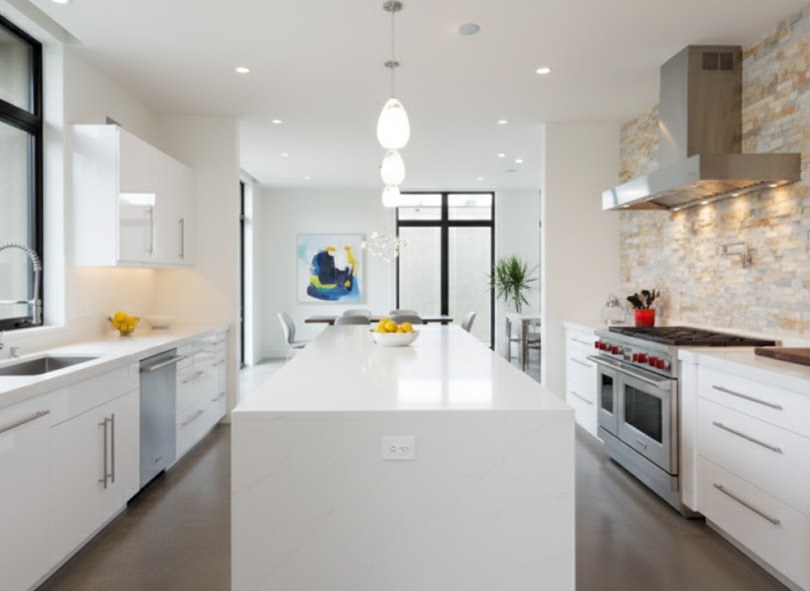Love the look of stacked stone but concerned about grease and heat exposure behind your stove? This guide shows proven ways to install, seal, and maintain stone for long‑term performance. You’ll learn how various stones withstand high temperatures, methods to protect porous surfaces from cooking splatter, and efficient cleaning techniques that keep their finish intact. By the end, you’ll be able to pair kitchen safety with the distinctive character only stacked stone offers.
The #1 Concern: Is a Stone Backsplash Safe Behind a Stove?
When positioning stacked stone directly behind a stove, heat exposure and code compliance must be addressed upfront. Choosing the right stone, installing it to code, and maintaining it properly ensures lasting performance and safety.
Heat Resistance of Stone Backsplashes
Natural stones such as marble, granite, slate, and quartz handle typical residential cooking temperatures well due to their non-combustible nature, making them dependable near stoves. For commercial appliances, expect higher sustained heat that can cause discoloration or surface changes even in dense stone. Engineered stones also resist heat effectively, but keep them clear of open flame and follow manufacturer temperature limits to prevent damage and warranty issues.
Installation Requirements for Safety
Use a fire-rated, non-combustible substrate such as cement board behind any stove-mounted stone backsplash to block heat transfer. Pair this with adhesives and grouts designed for high-temperature applications to prevent bond failure during heat spikes. Precision matters—your installer must follow manufacturer instructions and meet all local code requirements to secure both safety and durability.
Maintenance and Longevity of Stone Backsplashes
Seal natural stone after installation to prevent grease and splashes from penetrating, which makes cleaning simple and protects the finish. Use pH-neutral, stone-safe cleaners and avoid harsh chemicals or abrasives that can strip sealant and etch the surface. Reseal every 1–3 years based on usage to maintain appearance and heat resistance.
Design Considerations and Code Compliance
Verify local building codes before locking in your backsplash design. Many jurisdictions require specific clearances, protective materials, or extra shielding for gas appliances. In higher-heat zones, stainless steel trim or heat shields can reduce stress on the stone. Working with an experienced designer or installer ensures the finished kitchen meets regulatory standards without compromising aesthetics.

The ‘Heat Zone’ Problem: Will My Stove Damage the Stone?
When specifying a stacked stone backsplash behind a stove, balance visual impact with proven heat performance. Most failures occur when teams assume all stones respond the same to sustained heat. In reality, stone type, sealing, and installation decisions determine whether the backsplash will last or require costly remediation.
Heat Resistance of Natural Stone and Stone Veneer
Natural stone and quality stone veneer perform well under typical cooking conditions, but each species has a defined thermal limit. Dense materials like granite and quartzite tolerate sustained heat better than softer options; limestone can degrade when exposed to about 400°F (204°C) over time, causing surface changes. Versus ceramic, porcelain, or metal, stone often matches or exceeds heat tolerance but requires disciplined sealing and cleaning. For heavy daily stove use, select stone with heat resilience in mind rather than on aesthetics alone.
Types of Heat-Related Damage and Risk Factors
Heat damage manifests as discoloration, cracking, or spalling, especially in softer or porous stones. Risk escalates when stone is improperly sealed and oils hit hot surfaces—grease plus heat can penetrate deep, leaving permanent stains. Stone veneer also depends on adhesives and backing that withstand high temperatures; if these fail, bonds weaken, making product compatibility as critical as the stone face.
Sealing and Maintenance to Protect Stacked Stone Behind Stoves
Use a high-quality sealant immediately after installation to block heat penetration and staining—this is mandatory in high-use cooking zones. It shields against thermal shock and limits oil absorption. Reseal annually or biannually, and clean regularly with a soft brush, water, and pH-neutral stone cleaner to maintain the finish without stripping the seal.
Professional Installation Best Practices for Heat Resistance
Experienced installers mitigate heat risks by using heat-rated adhesives, sealing thoroughly, and preparing substrates with stable, heat-resistant backer boards like cement board instead of drywall. Following manufacturer specifications for stone and adhesive ensures the assembly performs as intended; cutting steps or mixing incompatible materials often leads to warping, loose panels, or heat marks that cost far more to fix later than to prevent upfront.

The ‘Practicality Gap’: How Do You Clean Grease Off Rough Stone?
Grease buildup on a stacked stone backsplash behind a stove doesn’t just diminish its look—it can shorten its service life if cleaned incorrectly. Natural stone’s depth and porosity lock cooking oils deep inside, unlike smooth tile. Effective cleaning means understanding these issues, choosing compatible products, and applying a methodical process that avoids costly surface damage.
Challenges of Cleaning Grease on Rough Stone Surfaces
Textured stacked stone has an irregular, porous structure that traps airborne grease and splatters. These same features that deliver visual depth make cleaning harder, as residue lodges in pores and cleft edges. Typical kitchen cleaners often coat the surface without reaching embedded oils, causing recurring stains and gradual darkening. Accessing the stone’s fissures takes more than wiping—wrong tools or aggressive scrubbing can chip edges or erode finishes. Professionals rely on methods that lift grease from recesses without abrasive or chemical damage.
Specialized Cleaning Products and Techniques
Start with a solvent-based degreaser formulated for natural stone, such as Faber No Oil, which penetrates beyond the texture to break down oil films. B2B installers often pre-dry surfaces before application to avoid dilution. For stubborn spots in high-heat zones, apply cleaner into deep voids with a spatula or detailing tool, allow the recommended dwell time, then lift residue using a soft brush or lint-free cloth. The objective is complete removal while preserving the stone’s sharp edges and split-face character.
Considerations for Different Stone Types
Marble, limestone, and many manufactured composites react poorly to acidic agents or abrasive pastes, leading to dulling or aggregate exposure. Using an incompatible cleaner can escalate routine maintenance into costly restoration. For supply chain stakeholders, verifying chemical compatibility before deployment protects assets and warranty compliance. Maintain a database of approved cleaners per stone category to guide homeowners and commercial operators toward safe, effective choices.
Maintenance and Aftercare Strategies for Stacked Stone Backsplashes
Preventing buildup is more efficient and cost-effective than remediation. Incorporate weekly light cleaning with a pH-neutral stone cleaner, particularly after cooking sessions that generate airborne grease. In commercial or showcase kitchens, service contracts should include scheduled deep cleans with professional-grade products. Select vertical-surface cleaners with controlled viscosity to ensure adequate contact time and minimize drips. Finish by applying a quality penetrating sealer to create a barrier that speeds future cleaning and reduces risk of permanent discoloration.
Elevate Projects with Genuine Ledger Stone
Explore durable, lightweight ledger stone that blends natural beauty and versatile design for interiors and exteriors. Experience faster installation and lasting performance that inspires designers and supports contractors. Partner with us for consistent quality and wholesale pricing on premium stone products.

The Pro’s Solution: How to Make Stone Non-Porous (The Right Sealer)
In high-use kitchens, a stacked stone backsplash behind a stove faces constant heat, grease, and moisture. Securing a non-porous finish protects your investment and cuts future maintenance. Selecting a sealer matched to the stone’s characteristics and applying it with disciplined preparation extends performance significantly. Follow this proven, step-by-step method used by professional installers for lasting results.
Assessing Stone Type and Porosity
Begin with a clear evaluation of the stone. Marble, granite, travertine, and slate each absorb moisture at different rates, which dictates sealer selection. Travertine’s open pores need more intensive sealing than dense granite. Use a quick water absorption test—place a few drops on the surface and time the penetration—to guide product choice. Skipping this step risks poor protection from mismatched sealers.
Selecting the Right Sealer for Kitchen Backsplashes
For stacked stone in cooking zones, penetrating (impregnating) sealers deliver lasting, invisible protection without changing the stone’s look. High-performance solvent-based sealers like FILA FOB handle deep absorption, while water-repellent treatments such as HYDROREP boost defense in heavy splash areas. Topical sealers can add resistance but require regular upkeep and can complicate cleaning if neglected.
Preparing Stone Surface Correctly Before Sealing
Preparation determines outcome. Clean thoroughly with a pH-neutral stone cleaner to remove grease, dust, wax, or old sealers—any residue will undermine bonding. Allow full drying, typically 24–48 hours, to prevent moisture entrapment. Professionals verify surface moisture with a meter, keeping readings below 4% to avoid vapor-related failures under the sealer.
Proper Application of Sealers
Apply in controlled sections of about 3 feet to ensure uniform coverage. Use microfiber cloths, lambswool applicators, or low-nap rollers for even saturation without streaks. Let the sealer penetrate for 5–15 minutes, then wipe excess before it dries to avoid hazing. For highly porous stone, apply a second coat 1–2 hours later to achieve full protection without over-layering.

Verifying Sealing Effectiveness and Safety Measures
Confirm results with a water drop test—beading means the seal is effective; if absorption occurs, spot reapply. Always work in a ventilated space and use gloves, eye protection, and a respirator when handling solvent-based products, as vapors can be harmful in enclosed environments.
Common Pitfalls and Maintenance Tips
Never seal damp or dirty stone—it traps impurities and weakens durability. Match sealer formulations to your specific stone to avoid residue or poor performance. Maintain the finish by following manufacturer resealing intervals, adjusted for the backsplash’s exposure to heat, steam, and splatter, to preserve the easy-clean, long-term protection you invested in.
How It Compares: Stacked Stone vs. Tile vs. Stainless Steel
Selecting a backsplash behind a stove impacts durability, hygiene, and upkeep as much as visual appeal. Each option responds differently to heat, splatter, and cleaning demands. The comparison below distills performance, maintenance, and design factors for stacked stone, tile, and stainless steel—so you can match specifications to project requirements and client priorities without guesswork.
| Matériel | Key Considerations Behind Stove |
|---|---|
| Stacked Stone Backsplashes | Natural granite, marble, or slate bring distinctive texture and stand up well to stove heat. Sealing is mandatory to guard against stains, and cleaning must avoid harsh agents due to porosity. Ideal for clients insisting on authentic materials—factor in recurring maintenance costs at the budgeting stage. |
| Tile Backsplashes (Ceramic, Porcelain, and Glass) | Ceramic and porcelain deliver smooth, glazed surfaces that wipe clean, resist stains, and offer strong value in heavy-use kitchens. Grout can discolor; darker or epoxy types reduce staining. Large-format tiles cut cleaning time. Glass tiles create a high-end finish and resist bacteria but demand skilled installation to handle heat and moisture effectively. |
| Stainless Steel Backsplashes | Highly heat-resistant and quick to clean, stainless steel fits fast-paced kitchens and achieves a modern aesthetic. It reduces upkeep time but shows fingerprints and scratches more readily than stone or tile. Use where streamlined design and low maintenance outweigh concerns over minor visible wear. |
Design Inspiration: Kitchen Backsplash Ideas That Work
Stacked stone backsplashes behind the stove deliver both style and performance. For designers and homeowners aiming to balance visual impact with longevity, stone’s natural beauty endures heavy use and cooking heat. Well-selected materials unify cabinetry, countertops, and appliances while maintaining durability where heat and splatter are concentrated.
Natural Stone Selection and Visual Appeal
Slate, marble, and travertine each bring distinct palette and texture options that align with cabinetry finishes or countertop materials. Slate delivers rugged elegance, marble offers refined polish, and travertine provides subtle warmth. Arranged in a stacked format, stone adds shadow and tactile depth that pair effectively with warm neutrals, earthy surfaces, or reclaimed wood — a finish valued for its authenticity in spaces saturated with synthetics.
Installation Approaches and Design Integration
Full-height installations behind the stove deliver maximum visual impact and anchor the cooking wall as a focal point, ideal for highlighting premium appliances or architectural detailing. Partial backsplashes or countersplashes scale down the visual intensity while keeping upkeep manageable. In both formats, stacked stone bridges bold cabinetry tones and softer surfaces, ensuring unified rather than segmented design.

Functional Benefits Behind the Stove
Natural stone withstands daily use with inherent heat, stain, and impact resistance, making it highly effective where temperatures and splatter are constant. Applying a high-grade sealant post-installation adds grease protection and simplifies cleaning, while heat resistance supports safe, long-term performance next to burners or vents — preserving both design value and kitchen safety.
Emerging Trends in Kitchen Backsplash Designs
Combining stone with stainless steel or glass mosaics creates layered textures that deliver a custom signature. Designers increasingly align backsplash choices with overall palettes and lighting schemes, ensuring the tactile appeal and authenticity of stone remain relevant even as markets trend toward multi-material, high-texture finishes.
Your Top Questions Answered (FAQs)
Homeowners often have practical concerns about using stacked stone backsplashes behind stoves. The following answers address safety, care, and performance based on our industry experience so you can make informed decisions for your kitchen projects.
Does a stacked stone backsplash meet fire safety codes?
Natural stacked stone is inherently non-combustible, making it well suited for areas around heat sources. It can comply with fire safety requirements as long as installation follows both local building codes and manufacturer guidelines. In practice, designers and contractors treat stacked stone as a safe, durable choice behind stoves, provided it’s anchored and backed with proper materials.
How do you clean grease splatter off rough stacked stone?
Use a soft-bristled brush with warm water for routine cleanup to keep the stone’s texture intact. For tougher grease, a pH-neutral cleaner formulated for natural stone will break down residue without dulling the finish. Avoid abrasive pads, harsh acids, or high-pressure washing since these can etch the stone and weaken grout lines over time.
What is the best sealer to use behind a stove?
Select a high-quality sealer formulated for porous natural stone so it blocks oil and grease penetration. Heat resistance and ease of cleaning are key attributes in a kitchen setting. Reseal at intervals recommended by the product manufacturer—often every year in active cooking spaces—to maintain protection and appearance.
Will the heat from the stove damage stacked stone backsplash?
Natural stacked stone withstands the heat from everyday cooking without cracking or fading. Like all backsplash materials, it should not be exposed directly to open flames. Sturdy backing boards and the correct adhesive during installation help the stone maintain integrity and resist heat-related stress for years.
How does a stacked stone backsplash compare to stainless steel or tile?
Stacked stone delivers a natural texture and warmth that stainless steel and ceramic tile don’t offer. It does require more attentive cleaning because of its uneven profile, but the visual impact in a kitchen often outweighs the added maintenance. Smooth materials like stainless and tile are easier to wipe, yet many clients prefer the distinctive character of stone.
The Final Verdict: Is It a Good Idea for Your Kitchen?
When evaluating a stacked stone backsplash behind the stove, weigh design impact against long-term functionality. The right stone type, precise installation, and disciplined upkeep can transform the cooking zone into a standout feature that retains both beauty and value. Stacked stone brings organic texture, depth, and heat tolerance, creating a custom focal point that mass-produced tiles cannot match.
Maintenance is manageable with a consistent routine. Grease and residue settle into the surface, so a soft brush and pH-neutral cleaner should be part of post-cooking cleanup. Quality installation—cement backer boards, high-strength adhesives, and full sealing—prevents detachment and heat damage. Hiring an installer experienced with stone in high-temperature environments is a prudent safeguard.
Although the upfront cost exceeds tile or stainless steel, increased property value and durability often justify the investment. For kitchens embracing natural textures and owners committed to regular care, stacked stone delivers both aesthetic appeal and resilient performance.
Final Take on Stacked Stone Behind the Stove
A stacked stone backsplash can perform reliably in high‑heat zones when paired with the right stone type and professional installation. Dense, non‑combustible materials such as granite or quartzite tolerate daily cooking temperatures, but they require a fire‑rated substrate, heat‑resistant adhesives, and consistent sealing to prevent degradation. Routine care—light cleaning with pH‑neutral products and resealing every 1–3 years—protects against grease penetration. When sourced correctly and installed by an experienced high‑heat specialist, stacked stone delivers lasting performance and remains a prominent visual anchor in the kitchen.

